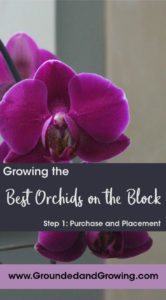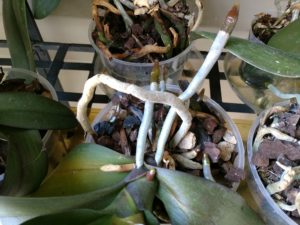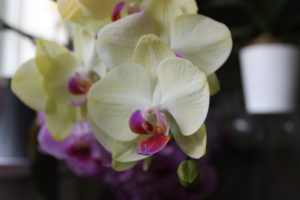 You’ve seen them. Colorful Phalaenopsis orchids for sale, each in a clear plastic sleeve and a colorful pot. They beckon to you from endcaps all over town—big box discount stores, grocery stores, and garden centers alike. You may have looked at the price tag and thought. Too expensive. I’ll just kill it. Don’t you need a greenhouse for orchids?
You’ve seen them. Colorful Phalaenopsis orchids for sale, each in a clear plastic sleeve and a colorful pot. They beckon to you from endcaps all over town—big box discount stores, grocery stores, and garden centers alike. You may have looked at the price tag and thought. Too expensive. I’ll just kill it. Don’t you need a greenhouse for orchids?
I think I fell in love with this mystique attached to orchids. There have such a reputation as fussy difficult plants, if you can keep one alive somehow that elevates you to “plant whisperer” status. I love a gardening challenge.
I don’t remember buying my first Phalaenopsis orchid, but I can say with confidence they were like potato chips—I couldn’t just have one. Today Phalaenopsis orchids are everywhere—even at the grocery store– but when I first bought mine they were still a little hard to find. Larger big box nurseries were just starting to carry them.
It wasn’t long before I made trips to specialty nurseries looking for different species of orchids or specialty Phalaenopsis. I even ordered them online. My good friend Janet was equally, if not more obsessed and we enabled each other in our quest to aquire mass quantities of orchids. Because that’s what friends do.
Janet and I got really smart and figured out we could buy orchid seedlings for a lot cheaper than blooming size orchids. That’s when things got out of hand for me.
I lived in a two-bedroom apartment, and I had a baker’s rack outfitted with fluorescent lights for my orchid collection in the second bedroom. Everything was growing like crazy and blooming and happy until I unknowingly brought in mealybugs which ended up wiping out my entire collection.
It was years before I bought another orchid.
When my son was a year old, I saw out-of-bloom Phalaenopsis orchids marked down to $3 at a big-box store that was really the last place you’d expect to find an orchid. Which probably at least partly explained why they had a whole table of orchids no longer in bloom on clearance.
I saw a plant that was resonably healthy, so I bought it. I told myself if I could resuscitate this orchid, I would maybe buy another. This was a far cry from my former behavior, where I would have bought all of what was on clearance and split it with Janet.
It took nearly a year for that orchid to bloom again; and since then I’ve added a few more to my new collection.
If you are intimidated by orchids, even if you’ve killed your fair share, there is hope. My best advice is to start with a Phalaenopsis orchid. They are hands down the easiest orchid to grow at home; that’s why you can get them just about anywhere these days.
I’ve been excited to write this post to give you a roadmap for success with orchids. I looked at it when I was done and it was more like a book than a post. So now we’ll just call it a “series” on orchids and I’ve split the information into three posts: this one on Purchase and Placement, Watering/Fertilizing and Pests, and Reblooming.
Let’s begin at the beginning, shall we?
When buying an orchid—know what a healthy plant looks like
- If there are flowers: look for plants that still have unopened flower buds—this means more time to enjoy the flowers at home. If all the flowers are open, who knows how much life they still have left before they fade.
- Healthy orchid leaves are firm and glossy; healthy roots are plump and have a white velvety coating and green tips. It’s totally normal for a few roots to grow over the edge of the pot. Most orchid pots today are clear plastic and you should be able to see plenty of healthy white or green roots in the pot. Wrinkled, floppy leaves and dark slimy or dried-up roots are a sign that the plant has not been watered properly. If the leaves are wrinkled it’s highly likely the roots have been severely damaged— these plants are not likely to recover. Out-of-bloom “clearance” plants can be a great way to try growing orchids at a fraction of the cost of an in-bloom specimen, but make sure the plant is healthy.

Healthy orchid roots!
- Don’t be afraid to look over every inch of an orchid to look for evidence of insect pests. If you find any, you should probably pass on that plant. It’s a good idea to keep new orchids away from your existing ones for at least a week or two, maybe longer, just to make sure they are pest-free. If I had done this I probably wouldn’t have had the mealybug infestation I had years ago.
- Depending on where you buy your orchid, the condition of the plant may well depend on how long it’s been in the store. I’ll never forget being in a big box store when the lawn and garden manager was barking at the employees, “We are in the business of selling plants, not growing them! Get these plants sold!” No doubt you have a store or two like this in your neck of the woods. You may find some awesome deals on neglected orchids from these establishments, or you may figure out when they get fresh shipments and shop then.
Home sweet home—determine the best place for growing your orchids and keep your plants there most of the time.
- It’s okay to display a flowering orchid in a less-than-ideal setting to show off the colorful blooms for a short time. But only do it for a day or two. More often than not, keep your orchids in a spot they love.
- Keep orchids away from warm and cold drafts; drafts shorten the life of orchid blooms, cause flower buds to drop and in extreme cases can damage or kill the plant.
- One of the reasons Phalaenopsis orchids are easy to grow is they prefer the same temperatures that we do—down to about 60°F at night and 70-80°F during the day. Windowsills can be great spots for orchids, but they can be a lot hotter or colder than the surrounding room, especially if there are drapes or curtains covering the window. I learned the hard way a couple of years ago that direct contact with cold windows (even if it’s not freezing outside) can damage plants.

Happy orchids in my southwest facing bathroom window.
- Thankfully Phalaenopsis are not divas about lighting; they thrive in the relatively low light indoors. Now this doesn’t mean put them up on a shelf in a dimly lit room; you do need an east or west window or lightly shaded south window for Phalaenopsis. Too much light can sunburn their leaves or cause blooms to drop. A good rule of thumb is if you have enough light in a location to grow an African violet, it should be a good spot for a Phalaenopsis too.
My Favorite Resources
The American Orchid Society— Hands-down my favorite resource for information on orchid care. Their website is particularly helpful when success with your Phalaenopsis gets you curious about caring for other orchid species. Membership gets you all sorts of bonuses including a “Your First Orchid” book and “Orchids” magazine.
Veg Ledge Suction-cup Shelving— If good lighting is limited, one way to expand the available space is window shelving. I love the Veg Ledge shelves. I’ve had them for about three years now and have had zero issues with them.
LED Plant Lighting— If you’ve read any of my houseplant posts, you know I’m a convert for using LED grow lights. They used to be crazy expensive, but they are super affordable now. The link here is for my favorite fixture which has three gooseneck light strips, a clip, and built in timer. My dream grow light setup is this one from Gardener’s Supply.
Once you’ve got your orchid safe and sound at home, now the anxiety fun begins. Will you be able to keep your orchid alive for longer than a few weeks? In my next post I’ll calm your anxiety and share tips for watering, fertilizing and controlling pest problems.
If you liked this post, please subscribe to Grounded and Growing today and receive your copy of “15 Tips to Become a '15 Minute Gardener'” so you can spend less time working ON your garden and more time enjoying being IN your garden.! It’s absolutely free. When you join the Grounded and Growing community, you’ll finally take the garden off your “To-Do” list and allow yourself time to enjoy your garden and savor the peace and serenity there. I tell subscribers about new posts as soon as I hit ‘publish’ and send weekly-ish updates on what’s going on in my garden– good, bad AND ugly.

All Rights Reserved. © 2017 Jennifer Schultz Nelson
Hope you will also cover how frequently I can expect my Phalaenopsis to rebloom. Because I have four or more growing right now without records of when they last bloomed, it seems like a long time between blooming periods. Thanks!
Yes absolutely! The third and last post will cover reblooming. Typically Phalaenopsis bloom once per year, at about the same time each year. It may not be the same time as when you purchased them though. I will cover what tricks I know for coaxing those stubborn ones that just seem to sit there healthy yet non-blooming….stay tuned!